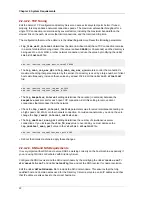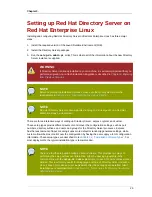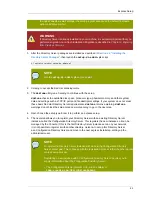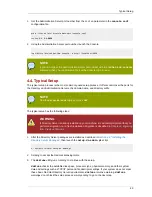
Chapter 3. Setting up Red Hat Directory Server on Red Hat Enterprise Linux
34
NOTE
Run the
setup-ds-admin.pl
script as
root
.
The custom setup has the following steps:
WARNING
If Directory Server is already installed on your machine, it is extremely important that you
perform a migration, not a fresh installation. Migration is described in
Chapter 8, Migrating
from Previous Versions
.
1. After the Directory Server packages are installed as described in
Section 3.2, “Installing the
Directory Server Packages”
, then launch the
setup-ds-admin.pl
script.
# /usr/sbin/setup-ds-admin.pl
2. Select
y
to accept the Red Hat licensing terms.
3. The
dsktune
utility runs. Select
y
to continue with the setup.
dsktune
checks the available disk space, processor type, physical memory, and other system
data and settings such as TCP/IP ports and file descriptor settings. If your system does not meet
these basic Red Hat Directory Server requirements,
dsktune
returns a warning.
dsktune
warnings do not block the setup process; simply entree
y
to go to the next step.
4. Next, choose the setup type. Accept the default, option
3
, to perform a custom setup.
5. Set the computer name of the machine on which the Directory Server is being configured. This
defaults to the fully-qualified domain name (FQDN) for the host. For example:
Computer name [ldap.example.com]:
NOTE
The setup program gets the host information from the
/etc/resolv.conf
file. If
there are aliases in the
/etc/hosts
file, such as
ldap.example.com
, that do
not match the
/etc/resolv.conf
settings, you cannot use the default hostname
option.
The hostname is very important. It is used generate the Directory Server instance name, the
admin domain, and the base suffix, among others. If you are using SSL/TLS or Kerberos, the
computer name must be the exact name that clients use to connect to the system. If you will use
DNS, make sure the name resolves to a valid IP address and that IP address resolves back to this
name.
6. Set the user and group as which the Directory Server process will run. The default is
nobody:nobody
. For example:
Содержание DIRECTORY SERVER 8.0
Страница 32: ...24 ...
Страница 46: ...38 ...
Страница 90: ...82 ...
Страница 98: ...90 ...
Страница 128: ...120 ...
















































